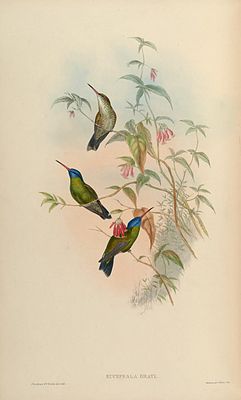Blue head sapphire
| Blue head sapphire | ||||||||||
|---|---|---|---|---|---|---|---|---|---|---|

Blue-headed sapphire (♀ above, ♂ below), depiction of John Gould |
||||||||||
| Systematics | ||||||||||
|
||||||||||
| Scientific name | ||||||||||
| Hylocharis grayi | ||||||||||
| ( Delattre & Bourcier , 1846) |
The blue-headed sapphire ( Hylocharis grayi ) or sometimes also the blue-headed sapphire hummingbird is a species of bird from the hummingbird family (Trochilidae). The species has a large range that covers about 39,700 square kilometers in the South American countries of Colombia and Ecuador . The IUCN assesses the population as not at risk ( least concern ).
features
The blue-headed sapphire reaches a body length of about 8 to 9 centimeters. The straight, coral-red, pointed beak is about 22 millimeters long. In the male, most of the body is shimmering green. The entire head and neck shine blue. The slightly forked tail is colored dark blue. The female is shimmering green on the upper side; its underside is white with green spots on the neck and chest. The black tail has white speckles.
Habitat
The hummingbird is confined to a local area. In the drier interior of the country, it is preferred to see it in the undergrowth or in lighter forests. The bird is usually found at altitudes up to 2000 meters. Its home is among others in the area around Cali and Buga .
behavior
The blue-headed sapphire feeds on flower nectar on flowering plants at different altitudes. It can also be seen in the tree tops in bloom with other birds. His behavior is considerably aggressive.
Subspecies
So far no subspecies are known. Earlier there were the Humboldt Sapphire ( Hylocharis humboldtii ) as a subspecies to Hylocharis grayi . It is now recognized as a separate species. The species is considered to be monotypical .
Etymology and history of research
Jules Bourcier and Adolphe Delattre originally described the hummingbird under the name Trochilus Grayi . The species was first discovered in Popayán (Colombia). It was only later assigned to the genus Hylocharis Boie , in 1831.
The word Hylocharis is made up of the Greek words "hyle" for "forest landscape" and "charis" for "grace, beauty". The specific epithet grayi was awarded in honor of John Edward Gray (1800-1875).
literature
- Steven Leon Hilty , William Leroy Brown : A guide to the birds of Colombia . Princeton University Press, Princeton 1986, ISBN 978-0-691-09250-8 .
- Frank Gary Stiles: Notas taxonómicas sobre aves colombianas. I. El rango taxonómico de Hylocharis humboldtii. (Trochilidae) . In: Ornitología Colombiana . tape 1 , 2003, p. 68–70 ( ornitologiacolombiana.org [PDF; 532 kB ]).
- James A. Jobling: A Dictionary of Scientific Bird Names . Oxford University Press, Oxford 1991, ISBN 978-0-19-854634-4 .
- Jules Bourcier, Adolphe Delattre : Description de quinze espèce nouvelle de Trochilidèe, faisant partie de collections rapportées par M. Ad. De Lattre dont le précédentes excursions ont déjà enrichi plusieurs branches de L'histoire naturelle, et provenant de L'intérieur de Pérou, de républiques de l'Équateur, de la Nouvelle-Grenade et del'Isthme de Panama . In: Revue zoologique par la Société cuviérienne pour l'avancement de la Zoologie, de l'Anatomie comparée et de Palaeonthologie; Journal mensuel . tape 9 , 1846, pp. 305-312 ( biodiversitylibrary.org ).
- Friedrich Boie: Comments on species and some ornithological families and clans . In: Isis von Oken . tape 24 , 1831, pp. 538-548 ( biodiversitylibrary.org ).
Web links
- Amazilia grayi inthe IUCN 2011 Red List of Threatened Species . Posted by: BirdLife International, 2009. Retrieved July 23, 2011 ..
- BirdLife International: Species Factsheet - Blue-headed Sapphire ( Amazilia grayi ) . Retrieved July 23, 2011.
- Videos, photos and sound recordings of Blue-headed Sapphire (Hylocharis grayi) in the Internet Bird Collection
- Blue-headed sapphire ( Hylocharis grayi ) from Avibase; Retrieved April 6, 2014.
- Hylocharis humboldtii in the Integrated Taxonomic Information System (ITIS). Retrieved April 6, 2014.
- xeno-canto: Sound recordings - Blue-headed Sapphire ( Hylocharis grayi )
Individual evidence
- ^ Frank Gary Stiles: Notas taxonómicas sobre aves colombianas. I. El rango taxonómico de Hylocharis humboldtii. (Trochilidae). P. 68.
- ↑ a b c Steven Leon Hilty u. a .: A guide to the birds of Colombia. P. 269.
- ^ IOC World Bird List Hummingbirds
- ↑ a b Jules Bourcier al: Description de quinze espèce nouvelle de Trochilidèe,… p. 307.
- ^ Friedrich Boie, p. 546.
- ↑ James A. Jobling: A Dictionary of Scientific Bird Names. P. 111.